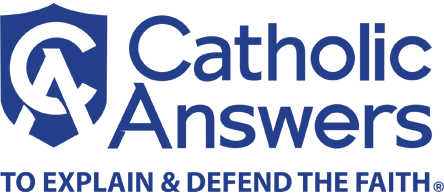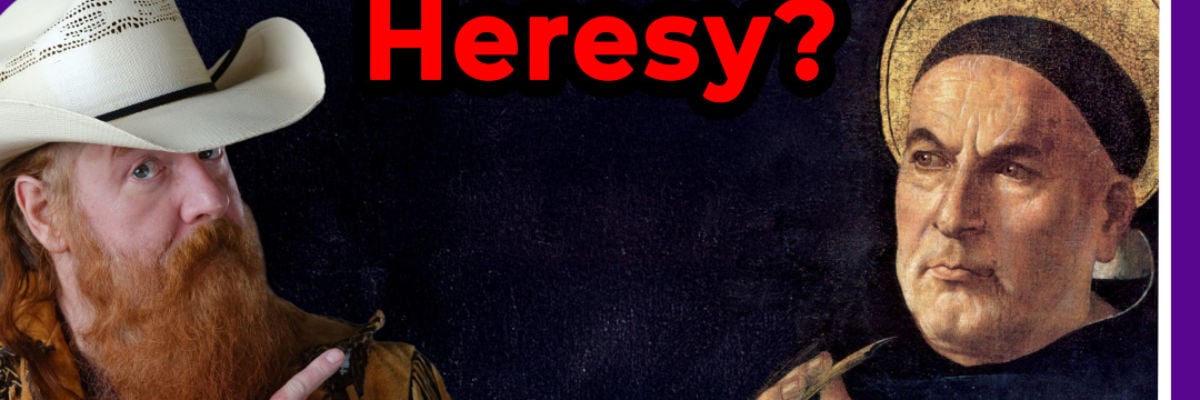
Audio only:
Dive into the latest episode of The Jimmy Akin Podcast, where Jimmy unravels the true meaning of heresy in Catholic theology! He explores its historical roots, clarifies misconceptions, and reveals why many accusations of heresy miss the mark. With insights from Aquinas, Canon Law, and Cardinal Müller, Jimmy equips listeners to navigate today’s heated ecclesial debates with clarity and precision. Don’t miss this engaging dive into dogma, faith, and the Church’s teachings—perfect for Catholics seeking truth amid confusion!
TRANSCRIPT:
Coming Up
Recently I contributed a couple of chapters to a book with other authors—including Cardinal Robert Sarah.
The book is edited by Andrew Likoudis and it’s called Faith in Crisis.
The overall topic of the book is how to think about various subjects in light of criticisms made by certain Traditionalists and the confusion this has caused.
A key term in many of these debates is heresy, and to help clear away confusion around this term, I contributed a chapter titled “What Is Heresy?”
Today, I’m going to share with you the substance of that chapter.
Let’s get into it!
* * *
Howdy, folks!
We’re in our second year of the podcast now, but I need your help to keep making it.
You can help me keep making this podcast for years to come—and get early access to new episodes—by going to Patreon.com/JimmyAkinPodcast
Introduction
It’s amazing how frequently the term heresy appears in some modern Catholic discussions and how freely some people apply it to the teachings of the Second Vatican Council, recent popes, bishops, theologians, and even laity.
We are living in a springtime of accusations of heresy, and charges of it bloom like wildflowers.
But when one examines these accusations closely, it becomes clear that many are poorly supported.
Sometimes the bare term heresy is used, without any explanation of why we should regard a particular statement as heretical.
Other times there is an explanation, but it turns out to be a bad one,
and it becomes clear that the author is not familiar with how the term is used by the Church.
This is unfortunate, because heresy is historically one of the most serious charges one can make against another Catholic.
It is not to be made lightly, and it is never to be made falsely.
For more on that, you can see the Catechism of the Catholic Church, paragraphs 2477-2479 (CCC 2477-2479), which have to do with the respect we owe to others reputations and the sins of rash judgment, detraction, and calumny—which people often commit when making charges of heresy.
It’s therefore important that we understand what the term heresy means and when it can and cannot be used.
The Term Heresy
Confusion over this term is understandable, because most people aren’t familiar with its history.
Popular dictionaries give loose, imprecise definitions, and in popular speech, Heresy means something like False religious belief or Really bad false religious belief,
but in Catholic discourse, heresy has come to have a very specific meaning,
and it does not cover nearly as many things as people imagine.
However, heresy hasn’t always been used this way.
Language changes over time, and when Christianity first began, the Greek word for Heresy—Greek, Hairesis—meant things like sect, party, school, or faction.
It also could mean things like choice, preference, and inclination.
Thus, in the New Testament, Paul uses the Greek word for heresy to refer to the Pharisees as “the strictest party (hairesin) of our religion” (Acts 26:5).
And—again using the Greek word for heresy—Christianity itself is referred to as “the sect (hariseôs) of the Nazarenes” (Acts 24:5).
With time, sects began to break away from Christianity (groups like the Docetists, the Montanists, and the Arians).
And the term heresy came to be applied to them and to their distinctive beliefs.
Consequently, by the Middle Ages, St. Thomas Aquinas could define heresy as
Summa Theologiae II-II:11:1
A species of unbelief, belonging to those who profess the Christian faith, but corrupt its dogmas.
The elements of Aquinas’s definition provide a framework for understanding heresy that is still used today.
It involves:
(1) Some kind of unbelief,
(2) By those professing to be Christians,
(3) Regarding the dogmas of the faith.
While each of these elements has subsequently been refined, they form the core of the modern definition of heresy, as we shall see.
The Term Dogma
A key term in Aquinas’s definition of heresy is dogma, and it also has changed meaning over time.
In the New Testament era, the Greek term Dogma meant things like ordinance, decision, or command, and so Luke can refer to how
Luke 2:1
A decree (dogma) went out from Caesar Augustus to register all the empire.
However, Dogma also could mean things like opinion, belief, and so it eventually came to be associated with all of the teachings and practices of the Christian Church.
Based on this broad definition of dogma, the field of Dogmatic Theology received its name, and it deals with the teachings of the Church in a wide sense.
Although, by the 1700s, the term dogma had a narrower meaning, dogmatic theology still retained its name.
In his book Catholic Dogmatics, Cardinal Gerhard Müller comments:
Catholic Dogmatics, vol. 1, Introduction
Though the name of this discipline (roughly since the eighteenth century) has been taken from the individual dogmas, dogmatics is not restricted to the dogmas in the formal sense: to certain doctrinal principles accepted in Catholic belief on divine authority due to a council or papal definition (e.g., the belief in Christ in the Nicene Creed or the dogma of the corporeal assumption of Mary in God’s glory).
Dogma means here the whole of Christian belief in terms of the creed and practice of the Church.
Here we see Cardinal Müller distinguishing between the older meaning of the term dogma—the whole of Christian belief in terms of creed and practice—and the more specialized meaning that was adopted in the 1700s.
Because since the 1700s the Church has used a narrower definition of dogma.
So what is that meaning?
The short answer is that A dogma is a teaching that the Church has infallibly taught to be divinely revealed.
Consequently, it calls for both Divine Faith and Catholic Faith.
It calls for divine faith because it is divinely revealed, and it calls for Catholic faith because the Magisterium of the Church has infallibly defined it as such.
What Heresy Means Today
This means that heresy, which is a rejection of dogma, is now defined as follows in the current Code of Canon Law:
Code of Canon Law (1983) can. 751
Heresy is the obstinate denial or obstinate doubt after the reception of baptism of some truth which is to be believed by divine and Catholic faith.
Although the elements are in a different order, this is fundamentally the same definition that was found in the 1917 Code of Canon Law. According to it:
Code of Canon Law (1917), can. 1325 §2
After the reception of baptism, if anyone, retaining the name Christian, pertinaciously denies or doubts something to be believed from the truth of divine and Catholic faith, [such a one is] a heretic.
In both definitions, we see the same three elements that Aquinas offered.
First, Aquinas said heresy involves “a species of unbelief,” which the 1917 Code refers to by saying heresy involves someone who “pertinaciously denies or doubts” and the 1983 Code refers to by saying someone has “obstinate denial or obstinate doubt.”
Second, Aquinas said heresy is committed by “those who profess the Christian faith,” the 1917 Code said it was committed “after the reception of baptism . . . [by] anyone, retaining the name of Christian,” and the 1983 Code said it is committed “after the reception of baptism.”
Third, Aquinas said heresy involves the rejection of “dogma,” the 1917 Code said it involves the pertinacious denial or doubt of “something to be believed from the truth of divine and Catholic faith,” and the 1983 Code similarly says it involves the denial or doubt of “some truth which is to be believed by divine and Catholic faith.”
So the same three elements that Aquinas identified—Nonbelief, After Baptism, of a Dogma—are still part of the modern understanding of heresy.
However, to qualify as the canonical crime of heresy—or what is sometimes termed Formal Heresy—all the elements listed in the 1983 Code of Canon Law must be fulfilled.
However, in contrast to formal heresy, people sometimes speak of Material Heresy.
Material heresy applies when the person is not fully culpable for his act.
As such, the qualifications “pertinaciously” and “obstinate” used in the 1917 and 1983 Codes would not need to be fulfilled for Material Heresy.
But the other conditions do need to be fulfilled for both formal and material heresy.
Heresy and Dogma
It is important to recognize that the Church uses the term heresy to refer specifically to a rejection of dogmas. A rejection of anything less than this may be bad, but it is not heresy.
We see this distinction in a 1989 document issued by the then-Congregation for the Doctrine of the Faith.
It was a commentary by Joseph Ratzinger and Tarcisio Bertone on the profession of faith required for various Catholic leadership positions by John Paul II.
This profession of faith includes the Nicene Creed followed by three added paragraphs.
The three added paragraphs respectively deal with (1) Dogmas, (2) Other infallible teachings, and (3) Non-infallible teachings.
The first paragraph reads as follows:
Professio Fidei
With firm faith, I also believe everything contained in the word of God, whether written or handed down in Tradition, which the Church, either by a solemn judgement or by the ordinary and universal Magisterium, sets forth to be believed as divinely revealed.
The doctrinal commentary then explains:
Doctrinal Commentary on the Concluding Formula of the Professio Fidei 5
The object taught in this paragraph is constituted by all those doctrines of divine and Catholic faith which the Church proposes as divinely and formally revealed and, as such, as irreformable.
These doctrines are contained in the word of God, written or handed down, and defined with a solemn judgement as divinely revealed truths either by the Roman Pontiff when he speaks ‘ex cathedra,’ or by the College of Bishops gathered in council, or infallibly proposed for belief by the ordinary and universal Magisterium.
These doctrines require the assent of theological faith by all members of the faithful. Thus, whoever obstinately places them in doubt or denies them falls under the censure of heresy, as indicated by the respective canons of the Codes of Canon Law.
That means the two codes of canon law currently in effect—the western one and the eastern one, or the 1983 Code of Canon Law and the 1990 Code of Canons of the Eastern Churches.
Notice how the doctrinal commentary describes these teachings as infallible (“irreformable,” “defined,” “infallibly proposed”), that they have been taught “as divinely revealed,” and that those who reject them commit “heresy.”
In other words, they are dogmas.
By contrast, the second added paragraph of the profession of faith deals with teachings that are infallible, but the Church has not infallibly taught that they are divinely revealed. The commentary states:
Doctrinal Commentary on the Concluding Formula of the Professio Fidei 6
The second proposition of the Professio fidei states: “I also firmly accept and hold each and everything definitively proposed by the Church regarding teaching on faith and morals.”
The object taught by this formula includes all those teachings belonging to the dogmatic or moral area, which are necessary for faithfully keeping and expounding the deposit of faith, even if they have not been proposed by the Magisterium of the Church as formally revealed.
Such doctrines can be defined solemnly by the Roman Pontiff when he speaks ‘ex cathedra’ or by the College of Bishops gathered in council, or they can be taught infallibly by the ordinary and universal Magisterium of the Church as a ‘sententia definitive tenenda’ [“opinion to be definively held”]. Every believer, therefore, is required to give firm and definitive assent to these truths, based on faith in the Holy Spirit’s assistance to the Church’s Magisterium, and on the Catholic doctrine of the infallibility of the Magisterium in these matters. Whoever denies these truths would be in a position of rejecting a truth of Catholic doctrine and would therefore no longer be in full communion with the Catholic Church.
Notice that, although these teachings “have not been proposed by the Magisterium of the Church as formally revealed,” they are nevertheless “taught infallibly” (“definitively proposed,” “defined”). However, since they are not dogmas, one is not guilty of “heresy” for rejecting them but of “rejecting a truth of Catholic doctrine.”
Heresy is thus the rejection of a dogma, and dogmas are a subset of infallible teachings: They are those that the Church has infallibly taught to be divinely revealed.
What this means is that, in order to accuse a person of heresy—formal or material—you must show that he is rejecting an actual dogma.
It is not sufficient to show that he is rejecting a common, long-held theological opinion (e.g., something Thomas Aquinas said).
Neither is it sufficient to show that he is rejecting something that the Church teaches—nor even that he is rejecting something that the Church has infallibly taught, because dogmas are a subset of infallible teachings.
Heresy is only committed when the person refuses to believe something that the Church has infallibly defined to be divinely revealed (as opposed to just infallibly teaching that it is true and somehow connected with matters of faith and morals).
Conclusion
Therefore, if you want to charge a council, a pope, a bishop, or anyone else with heresy, you will need to show that (1) He is denying something that the Church has taught, (2) that The Church has taught it infallibly, and (3) that The Church has infallibly taught it to be divinely revealed.
To do the latter two things, you will need to show when and how it was infallibly taught to be divinely revealed.
In other words, you can’t just quote a prior text from a theologian—even one as famous as Aquinas—or a previous papal or conciliar document, or even a set of them.
You’ll need to show that the documents in question use the language needed to trigger infallibility and that they communicate that this is a matter of divine revelation.
So, understood correctly, there are many fewer dogmas of the Church than is commonly supposed.
And far fewer Catholics are obstinately doubting or denying dogmas.
Consequently, a large number of charges of heresy are simply mistaken.
If you’d like to read about what I’ve discussed here, be sure and get a copy of Faith in Crisis.
The essays in this book equip Catholics to navigate today’s fiercest ecclesial debates.
The volume unfolds in three sections:
- The first section—on Traditionalism—exposes the roots of fundamentalist rigor, private-revelation subcultures, and reactionary dissent.
- The second section—on Church Authority—outlines papal primacy, collegiality, and the distinction between the ordinary and extraordinary Magisterium.
- The third section—on Reform—revisits Vatican II and the postconciliar reforms, synodality, ecumenism, and interreligious dialogue, showing that legitimate change is always a reform in continuity.
Amid a polarized media atmosphere and doctrinal fog, these essays offer the clarity and pastoral realism Catholics need to remain anchored in the Catholic Faith.
And, of course, there’s a reason I was asked to write this essay. I’ve written extensively about heresy, dogma, and Church teaching before.
So for an in-depth discussion of these matters, be sure and get a copy of my book Teaching With Authority.
I’ll have links to both books in the show notes and video description.
* * *
If you like this content, you can help me out by liking, commenting, writing a review, sharing the podcast, and subscribing
If you’re watching on YouTube, be sure and hit the bell notification so that you always get notified when I have a new video
Like I said, we’re in our second year of the podcast now, but I do need your help to keep making it.
You can help me keep making this podcast for years to come—and get early access to new episodes—by going to Patreon.com/JimmyAkinPodcast
Thank you, and I’ll see you next time
God bless you always!



